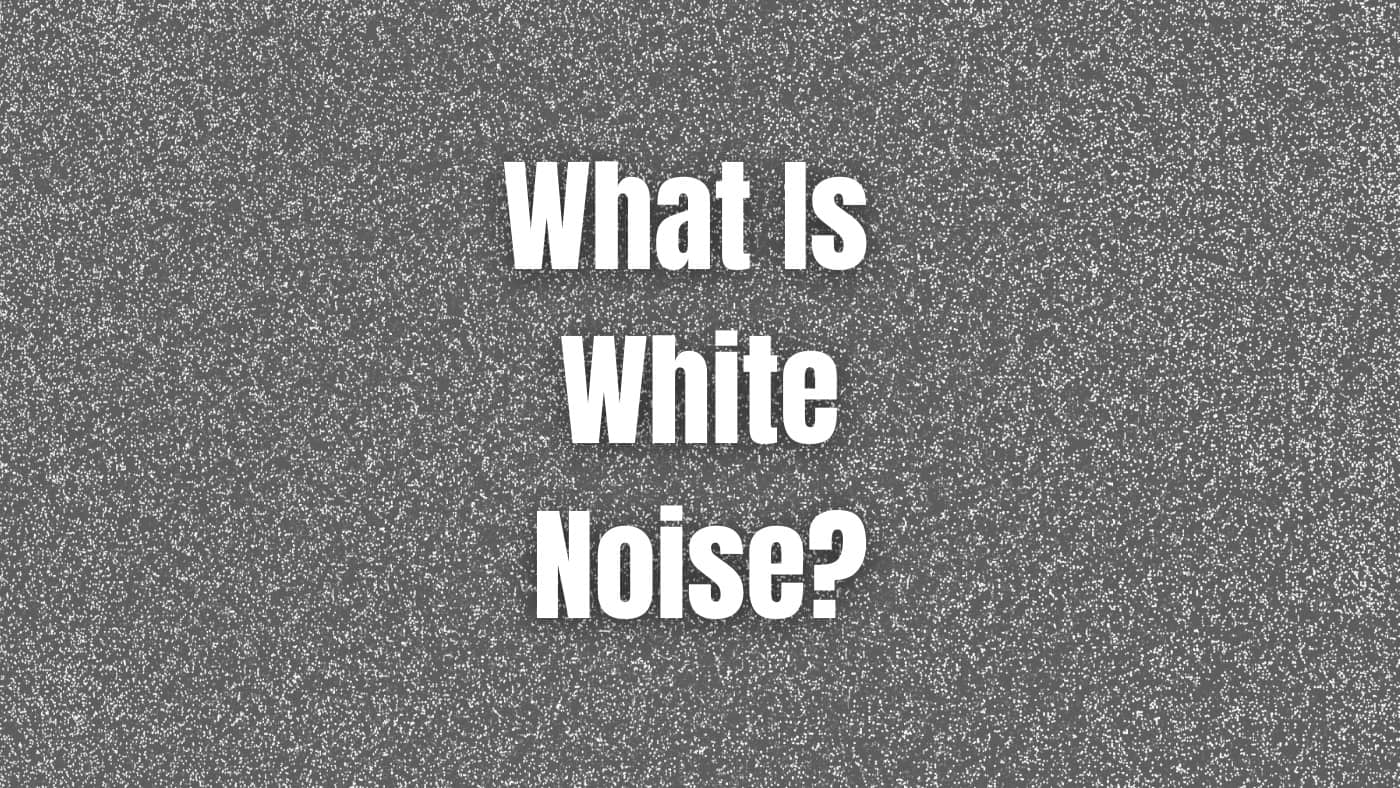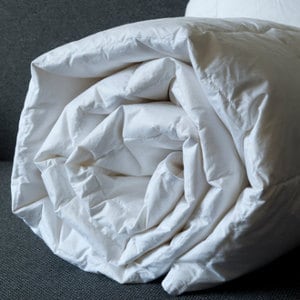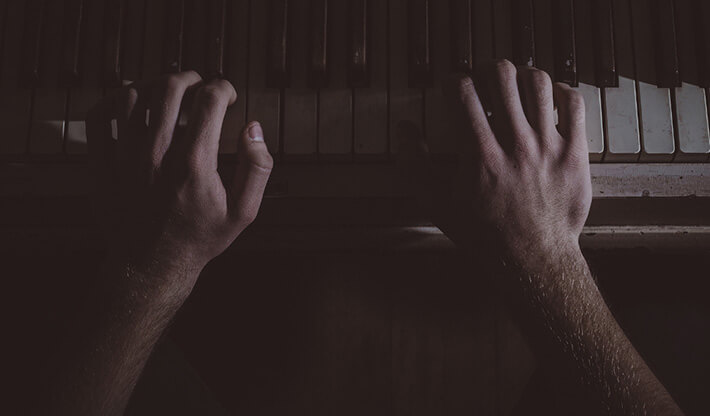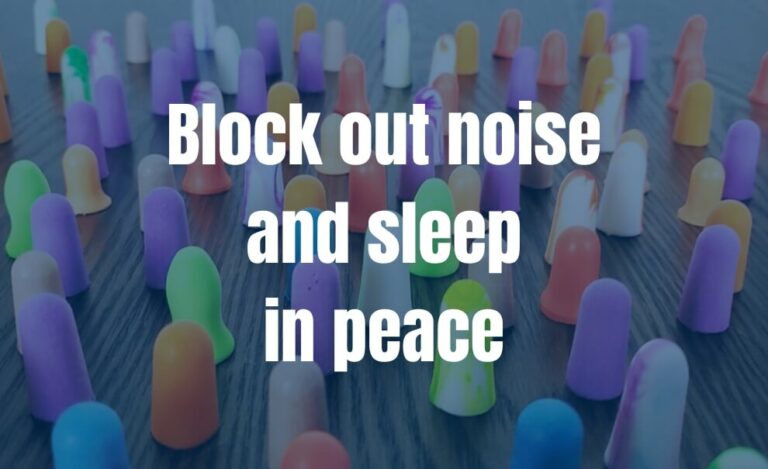
White noise sounds similar to the noise produced by an old-school analog television or radio when there’s no signal.
It’s a sound most people used to switch off as quickly as possible if it started blasting through the speakers.
So why is there a whole industry built around white noise production? And can it really help you sleep or concentrate better?
To understand why anybody would choose to listen to it, let’s first take a look at what white noise is exactly.
What white noise is
It’s helpful to start by looking at the name itself. White noise gets its name from ‘white light’. In simple terms, white light contains all colours, or frequencies of colour, combined together.
Similarly, white noise is a unique type of sound signal that contains all frequencies audible to the human ear, typically ranging from 20 Hz to 20,000 Hz. What makes white noise special is how these frequencies are distributed: it has equal power across all frequency bands of the same width.
To understand this, imagine dividing the entire range of audible frequencies into equal ‘slices’. In white noise, each of these slices contains the same amount of sound energy, regardless of whether it’s a low-frequency slice or a high-frequency slice. This even distribution of energy across all frequencies is what gives white noise its characteristic hissing sound.
It’s important to note that while white noise includes all audible frequencies, you might perceive it as sounding higher-pitched. This is because our ears are more sensitive to higher frequencies, and there are more distinct frequencies in the upper ranges of our hearing.
20,000 tones
The sound of white noise we hear as humans is the combination of all the frequencies between 20 and 20,000 Hz. So you’re literally hearing around 20,000 different tones of sound all at the same time, blended in a specific way.
If you think about it this way – imagine you’re sitting in a quiet restaurant. You’ll be able to pick out the individual voices of your companions, and perhaps those on nearby tables.
Now imagine you’re in a full sports stadium waiting for the game to start. There could be tens of thousands of people all talking at the same time, and it will sound like a blurred roar.
White noise has a similar effect. Because you hear so many different tones at the same time, it blurs into that ‘hissing’ or ‘shushing’ sound.
It’s also why nature sounds, such as rain, wind, waterfalls, or oceans, are often included on white noise machines and apps. There are so many different tones created by those forces of nature, that they sound like different types of natural white noise.
Why does white noise often sound high-pitched?
Although white noise contains all audible frequencies in equal measure, many people perceive it as sounding quite high-pitched. This perception is due to how our ears and brain process sound:
- Frequency Distribution: There are more distinct frequencies in the higher ranges, resulting in more ‘activity’ at the top end.
- Ear Sensitivity: Our ears are more sensitive to higher frequencies, particularly in the range of human speech (2,000 to 5,000 Hz).
- Logarithmic Hearing: We perceive pitch logarithmically, making higher frequency differences seem more pronounced.
These factors combine to make the higher frequencies in white noise stand out, even though they don’t actually contain more energy.
This is why some people prefer pink or brown noise, which have reduced higher frequencies and often sound more balanced to our ears.
What is pink noise?
The simple explanation is that pink noise is a variation of white noise which sounds deeper, and with less of a high-pitched hiss.
The more complex explanation revolves around why white noise sounds high-pitched in the first place.
The reason is that each octave contains twice as many frequencies as the one below it. For example, between 100 Hz and 200 Hz there are 100 distinct frequencies.
But between 200 and 400 Hz there are 200 frequencies. So by the time you get to 20,000 Hz, there are many more frequencies than there were at the lower end of the range.
When pink noise is created in a sound lab, the sound engineers will usually reduce the volume of each successive octave by three decibels to compensate for the extra frequencies.
This balances the sound out by giving more energy to the lower octaves, which makes it sound deeper than white noise.
What is brown noise?
Brown noise, sometimes called Brownian noise, sounds even deeper than pink noise, and considerably deeper than white noise. It’s sometimes described as sounding like the deep roar of a waterfall.
It’s not named after the colour brown, but after Robert Brown, a botanist who first observed the random movement of particles suspended in a fluid. This phenomenon is now known as Brownian motion.
Unlike white or pink noise, brown noise has a power density that decreases six decibels per octave with increasing frequency (or increases six decibels per octave with decreasing frequency). This means it has even more energy at lower frequencies than pink noise, resulting in that deep, rumbling sound.

Can brown noise make you lose bowel control?
The famed ‘brown note’ is allegedly a particular low-frequency sound that induces involuntary bowel movements. As entertaining as this urban myth might be, there’s no evidence that brown noise can cause such a drastic loss of control.
Various investigations, from scientific studies to military research and even documentary features, have explored the existence of such a universal frequency. Their conclusion? No singular ‘magic’ frequency with such an unpleasant effect exists.
While certain frequencies might sound unpleasant to some people, there isn’t a unique sound potent enough to send a crowd rushing towards the restroom.
What is white noise useful for?
Because white noise contains all audible frequencies, its most common use is to mask unwanted sounds. There are several situations where some people (though not all) might find that effect useful.
1. It can mask disruptive noise while you sleep
White noise is sometimes helpful for light sleepers who are disturbed by external sounds. For example, if city sounds like traffic or someone’s loud music is keeping you awake, white noise can effectively mask these irritating noises.
For this to work, however, the white noise needs to be at a sufficient volume.
Another reason why white noise helps at nighttime lies in the nature of our brain: it thrives on stimulation. Sudden or variable noise at night can activate our brain, disrupting our rest. A consistent white noise makes it less likely our brain will be stimulated by other environmental sounds.
If this sounds all too familiar, try experimenting with different types of white noise. If rumbling traffic or distant car horns disturb your sleep, see if pink or brown noise helps block it out.
2. It may help babies sleep
Babies are more sensitive to sudden sounds and may benefit from the careful use of white noise (see below for more on using white noise safely). As with adults, it can effectively mask abrupt noises, which may be a bigger problem during daytime naps when the world isn’t so quiet.
Moreover, the womb isn’t silent, so babies are already used to a constant source of noise. The hum of white noise may replicate the familiar sound of blood flow in the womb.
3. It might help you concentrate – for a while
While writing this article, I’ve been listening to pink noise constantly. I can hear the sound of traffic quite loudly from where I work, but the pink noise completely drowns it out.
I find it stops me from being distracted (and irritated!) by the fluctuating traffic volume, roaring motorbikes, thunderous trucks, and random angry drivers beeping their horns.
I find it’s very effective and I’m so used to the sound now that as soon as I put it on I feel focused, and the pink fades nicely into the background.
It’s also sometimes used by people who work in other kinds of noisy environments, such as manufacturing or where there’s a drone of technological devices.
Despite my positive experience with white noise, some studies have suggested continuous white noise usage might negatively impact performance, stress levels, and memory.
And research into whether white noise boosts concentration in children with attention difficulties has found mixed results.
The verdict is still out then. Personally, I prefer pink noise to cars, but I rarely listen to it for many hours at a time. And I can understand why some people might just find that it’s a case or replacing one annoying noise with another!
4. It might make tinnitus less noticeable
Speaking from personal experience, white noise does help me notice my tinnitus less. I had chemotherapy as part of my cancer treatment back in 2012, and one of the long-term side effects has been tinnitus.
It’s not too bad most of the time, so I don’t regularly use white noise for that specific purpose. But I’ve experimented with different colours of white noise and found it’s quite easy to completely mask the tinnitus. I don’t know if it will be as easy for those with more severe tinnitus, but it could be worth trying.
5. It may help with relaxation
Many people find the natural sound of oceans, rivers, waterfalls, or rain relaxing and peaceful. It may not be for everyone, but I imagine most people know that one of the joys of being in nature is listening to the sounds.
So the next time you’re feeling stressed, why not have a listen to the sound of an ocean or waterfall and see if it helps you unwind?
Can white noise help with sleep? What the research says
A number of studies have looked into the potential of white noise to improve sleep quality. let’s take a look at a few that I found interesting.
1. Adults in noisy New York
In 2021, researchers undertook a study into the effects of white noise on the sleep of New Yorkers.
It was only a small-scale study involving ten people, but it’s an interesting one as they recruited participants from a sleep clinic who reported noise as being a factor in their sleep problems.
The researchers found that both subjective and objective measures showed improvements in sleep in the group that was exposed to white noise.
I’ve used the white noise machine they had in the study myself – the Dohm Classic. It’s actually one of the quietest white noise machines I’ve used, with a real fan inside than makes a soft hum. So it’s interesting that they had such positive results with a relatively gentle white noise machine.
2. Adult patients in a critical care unit
In 2016, researchers in Iran undertook a study to see if white noise would help patients in a critical care unit sleep better.
The patients were divided into two groups. One group was exposed to white noise at 50-60 decibels, while the other group experienced the standard sounds of a hospital ward.
At the onset, no discernible difference in sleep quality was observed between the groups. However, after three days, those exposed to white noise reported significantly better sleep than the control group. Their conclusion was as follows:
Sleep disorders are more common among patients in intensive care units. Environmental factors like noise is a common cause of sleep disorders. Based on the findings of this study, the use of white noise is recommended as a method for masking environmental noises, sleep induction, improving sleep, and maintaining sleep in the coronary care unit.
3. Adult patients recovering from heart surgery
In a study conducted in 1992, a researcher at Huntsville Hospital in Alabama examined the effects of white noise on the sleep of patients recovering from heart surgery.
For this study, 30 patients were played ocean sounds via a white noise machine, while another 30 were exposed to the typical sounds of the ward.
They found no difference in the groups’ sleep latency – the time it took to fall asleep. However, the group listening to white noise reportedly had better overall sleep. This was based on better results for ‘sleep depth, awakening, return to sleep, quality of sleep, and total sleep scores’.
The researcher’s conclusion was as follows:
The use of ocean sounds is a viable intervention to foster optimal sleep patterns in postoperative CABG patients after transfer from the ICU.
4. White noise reduces the effect of changing noise levels in an intensive care unit
In 2004, a study was conducted to determine whether the volume of environmental noises, changes in that volume, or both, were more disruptive to sleep in an intensive care unit. The study also explored if white noise could mitigate this disruption.
Interestingly, the researchers used Polysomnography – the gold standard of sleep monitoring – rather than relying on subjective or observational measures of sleep.
The findings suggested that white noise helped by minimising the difference between the usual background noise and louder, abrupt noises.
The researchers stated that:
Peak noise was not the main determinant of sleep disruption from ICU noise. Mixed frequency white noise increases arousal thresholds in normal individuals exposed to recorded ICU noise by reducing the difference between background noise and peak noise.
This study would appear to back up one of the most popular uses for white noise – preventing sudden external sounds from waking people up during sleep.
5. White noise helped newborns fall asleep faster
In 1990, a team of researchers at Queen Charlotte’s Hospital in London conducted a study to evaluate the effects of playing white noise to newborns aged between two and seven days.
The newborns were divided into two groups of 20. One group was monitored in silence in their cots to determine how long it took for them to fall asleep.
The second group was exposed to white noise played through a standard white noise machine (positioned adjacent to the cot, 30 cm from the head).
It was observed that 16 (80%) of the newborns fell asleep within five minutes when exposed to white noise. In contrast, only 5 (25%) fell asleep within five minutes without the white noise.
The researchers noted two fascinating findings. Firstly, white noise at lower frequencies was more effective. Secondly, white noise didn’t help sooth the newborn if they were hungry, but it did help once they had been fed.
Addressing safety concerns when using white noise for newborns
This next study didn’t examine the effectiveness of white noise, but I think it has important safety advice if you’re a parent thinking of playing white noise to a child.
In 2014, a study of infant sound machines by researchers at the University of Toronto gained international media attention.
The researchers found that all 14 white noise machines they tested had a maximum volume level that could potentially harm a child’s hearing and auditory development. The volume of all of them was greater than 50 A-weighted dB when placed 30 cm away.
The main point made by the researchers wasn’t to condemn the use of white noise, but rather to advocate for the safer construction and use of sound machines.
Guidelines for the safe use of white noise
The researchers advised manufacturers to lower the maximum volume, include safety warnings, and have auto-off timers.
They also provided some useful guidelines for parents when using an infant sound machine (ISM):
1. Place the ISM as far away as possible from the infant and never in the crib or on a crib rail.
2. Play the ISM at a low volume.
3. Operate the ISM for a short duration of time (using one that has an auto-off timer).
What all of the above studies suggest is that scientific evidence appears to back up the potential of white noise to aid sleep for some adults and newborns.
However, if you use it to help children sleep, it’s important to do so in a safe way. Don’t play white noise at a loud volume or for extended periods of time, use an auto-off timer, and try not to become reliant on it when sleeping.
6. A systematic review of studies into white noise finds issues
In contrast to the studies above, not all researchers have found that white noise is helpful for sleep.
In 2021, researchers in the US conducted a systematic review of 38 articles. They found a lot of variability in the studies they looked at, with some showing that white noise disrupts sleep rather than aids it. They were also quite critical of the overall evidence, quoting examples such as small sample sizes.
So it would appear that although some studies have found that white noise can be helpful, a closer look doesn’t show that there is unanimous support for its use as a safe sleep aid.
What do white noise machine manufacturers say?
As you’d expect, the companies that make white noise machines all speak highly of the potential for white noise to improve sleep.
On the LectroFan website, for example, there’s a suggestion that it helps with noise changes:
When a noise wakes you up in the night, it’s not the noise itself that wakes you up, per se, but the sudden change or inconsistencies in noise that jar you. White noise creates a masking effect, blocking out those sudden changes that frustrate light sleepers, or people trying to fall asleep.
They also explain why it can be helpful for babies. They point to the ‘shushing’ sound that parents naturally make to calm their babies, explaining that white noise is a way of ‘outsourcing’ your shushing.
The company behind LectroFan also believes that white noise creates a safe environment by blocking out noise that can be overstimulating. They say it reduces the number of sudden disturbances from siblings, TVs, and music.
Yogasleep (formally Marpac) says on their website that white noise can help if snoring keeps you awake, or if you live in a loud environment.
They suggest that it provides a consistent sound environment that’s especially soothing to infants, but also for adults.
They also propose the interesting idea that parents can continue normal activities without tiptoeing around the house.
My personal experience
I tend to sleep best when I have complete silence and I regularly earplugs to shut the world out as much as possible.
However, earplugs don’t always do the trick as they can only reduce so much noise. So on noisier nights, or when away from home, I sometimes listen to pink or brown noise. This might be through headphones or a white noise machine – both work well for me.
However, I find I have to play white noise on a relatively low volume, otherwise the loud sound keeps me awake, no matter how relaxing and good at masking other noise it may be.
I also find that white noise in the form of natural sounds, like rain and waterfall, helps me relax and fall asleep. And if I have a way to mix different sounds, like rain and river, I find that’s very relaxing to listen to and good at blocking out external noise too.
Your views
Do you listen to any type of white noise to help with your sleep, work, or studies? What kind of white noise do you find works best? Let me know in the comments below!





I am concerned about starting the use of any noise-generating machine to help me stay sleeping through the night, and during napping. My question is won’t I get so accustomed to the white or pink noise that I will get “hooked” on it? My audiologist says you use it, then ween off and somehow that works, but I am skeptical.
Hi Christine
Thanks for your comment. I think it’s a valid worry that any new technique that helps us sleep better will become something we rely on. Some things are entirely positive anyway, so it’s not such a concern. But with white noise, I think as long as your mindful of how you use it, and try not to become dependent on it – perhaps using timers for example, you can maintain better control.
Regards
Ethan
Hi Ethan,
Just found your website now because I’m trying to understand how these colored noises affect the brain and sleep.
Brief background, I’ve been using earplugs at night to get rid of the noises that my flatmates make all night long, esp. those 2 rooms on both sides of my room. A couple of years ago, I first tried white noise by turning on the radio loudly without frequency, that didn’t mask the banging of doors and kitchen noises, So I then used earphones to listen to white noise and turned the volume high a bit to mask the annoying external sounds. Initially It helps with me falling sleep because it deactivates my hyper active brain, but in the morning I always have a tinnitus. For a couple of months I did that, but it came to a point that the tinnitus is becoming stronger, so I stopped and relied on disposable earplugs instead. For a year, I’ve used earplugs but this has effects too, like dried ear canals and itchiness that wakes me up in at night. I remedied the itchiness by cotton swab with petroleum jelly to clean my ears every 2 days, that also extended the life of the earplugs and I didn’t have to throw it even after 5 days of use.
But recently, about 2 months ago, I was so stressed at work and developed anxiety that kept my brain active at night, thus making me only sleep 2 hours every and the vicious cycle started – wanting to sleep but cannot because of fear of not getting enough sleep made me awake due to conscious sleep monitoring.
So last night, in desperation, I turned back to the noise, brown noise in my case. I had the amazing, energetic sleep I didn’t have in months! I didn’t turn the volume up too much to avoid the tinnitus, and I now can attest that colored noises are working for me to shut my brain up at night. It also makes me concentrate / focus better at work (this I’ve proven years back when I started listening to white noise, I didn’t have that headache that other are complaining about).
Btw, those soothing rain / spa/ thunderstorm noises didn’t work for me since I tend to listen to the ever changing noise instead of letting my brain shut down.
Hi Gray
Thank you for your comment. It’s not easy to deal with noisy flatmates, unfortunately.
I use earplugs regularly, and always throw them away after a couple of days rather than risk a build-up of dirt in my ear. And I also like brown noise compared to white noise. Like you say, keeping it on a lower volume is better – and safer.
Regards
Ethan
Newer studies show that white noise is actually detrimental to the brain. Much healthier is to use noise that varies in pitch and frequency, mimicking the natural world (and conversations).
Hi Diane
Thanks for your comment. The article has been updated with an interesting study that was done into the volume levels of sound machines, and safety advice from the researchers.
Regards
Ethan
Absolutely agree with you on this. I have been exposed to white noise at my place of employment for several weeks and up to several months on and off. At times the white noise speakers around me sounded very loud, I’ve developed headaches overnight, a pressure sensation in both my ears, tingling and several other effects that I can only relate to the technology being used.
Eventually, the speakers were turned off due to numerous complaints of having to hear the constant hissing sound (noise really).
Since then all for me has returned to normal and what I was experiencing is completely gone now. The effects took about a week to disappear completely. The technology may be good for some but not others. Perhaps those with supersensitive hearing will experience what I did. Not sure what others think about it but it was definitely affecting me.
Since then I have moved to a new office location and they have speakers emitting white noise all day. I have opted to use a set of noise muting headphones to block all sounds including speech. This seems to work fine for me since I don’t hear anything now as long as I have the headsets on.
If I don’t have them on because I am on the phone or talking to someone, I hear the white noise speakers in the background.
I try not to stay sitting all day in front of my computer but even that may be perceived as not being productive.
Advice for corporations out there, Implementing technologies should be thoroughly researched before they are implemented in the workplace.
Hi SB
I can imagine listening to white noise all day would be a bit much. I quite like it for a couple of hours on an occasional day if there is annoying noise outside my study. But every day all day would drive me up the wall!
Regards
Ethan
Really, for me it is the varies in pitch and frequency which actually wake me up especially conversations! The white noise which helps me sleep is a very low humming sound much like the brain wave frequency.
Very different for my mother and husband who readily fall asleep in front of the television. Oh how I envy them!
We have white noise in the office. It plays all day long and it doesn’t cut out the sounds or people talking since it travels down the hallways. What’s more annoying is that it’s programmed at intervals and I can even tell the time. It’s on very soft at 8, then up one level at 8:15 and then up another level at 8:30 and stays constant for the rest of the day. Everyone in the office is okay with it (or people are afraid to say something) so makes me think I’m the crazy one? I feel I’m working in a Coke bottling plant with the constant roar of the conveyor belt. I think it might be the pitch since the desk fan I have doesn’t bother at all. My dentist installed white noise in their waiting room and I stopped going to their office a few years ago. I really, really and truly hate white noise!
Hi Xiao
Thanks for your comment. I can understand why you’d hate it if you have to listen to it all day! It would drive me crazy if I had to listen to it all day every day. Why did they install it as a permanent feature?
Regards
Ethan
Many of the hospitals installed it in our area and the boss thought it was a great idea to install it in our office as well. Funny thing is that none of the speakers are installed near their office doors so they don’t have to listen to it. They claim that it cuts down on the noise coming from other people when they are on the phone but I think it makes them talk a little louder.
Hi there
Yes, that might be the reality of using white noise in the office if it’s not properly thought out! Personally, I wouldn’t be too keen on having it constantly on in the office all day, every day!
Regards
Ethan
I agree with Lyn. How is possible to someone to get a better sleep listening to white noises? And, poor babies! It is a mere combination of unpleasant sounds. There are better and soothing choices to provide nighttime relaxation. Yes, the world
of science definitely went mad – as Lyn said. She is totally correct.
I don’t know how anyone could listen to white noise for long periods as I believe my neighbour is using some kind of white noise sound and it’s driving me nuts, my ears ache, I can’t sleep properly and when I do I wake up with headaches. I know it’s not in my head because I have recorded the noise to prove I’m not loosing my marbles or that I have tinnitus. Why would anyone find it relaxing and those poor babies, has the world of science gone mad or am I just losing the plot.
Hi Lyn
Thanks for your comment. There must be something unusual happening if you can hear white noise that loudly through a wall. Perhaps they are playing it loudly on a stereo, because no small device or phone would be loud enough to both go through a wall and cause someone else trouble. I would speak to them and ask them if they wouldnt mind playing it softer. You could also politely suggest that there is advice from specialists who say it should be played to young children as quietly as possible and still has the desired effect.
Regards
Ethan